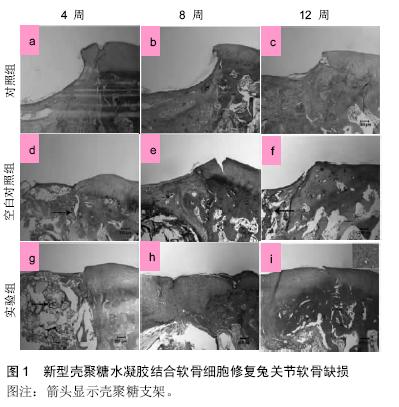| [1] Zeng L,Yao Y,Wang D,et al.Effect of microcavitary alginate hydrogel with different pore sizes on chondrocyte culture for cartilage tissue engineering. Mater Sci Eng C Mater Biol Appl. 2014;34:168-175
[2] Dahlin RL,Kinard LA,et al.Articular chondrocytes and mesenchymal stem cells seeded on biodegradable scaffolds for the repair of cartilage in a rat osteochondral defect model. Biomaterials.2014;35:7460-7469.
[3] Hu X,Ma L,Wang C,et al.Gelatin Hydrogel Prepared by Photo-initiated Polymerization and Loaded with TGF-β1 for Cartilage Tissue Engineering. Macromol Biosci. 2009;9(12): 1194-1201.
[4] Zhu S,Zhang B,Man C,et al.Combined Effects of Connective Tissue Growth Factor-Modified Bone Marrow-Derived Mesenchymal Stem Cells and NaOH-Treated PLGA Scaffolds on the Repair of Articular Cartilage Defect in Rabbits.Cell Transplant.2014;23:715-727.
[5] Fan W,Wu C,Miao X,et al.Biomaterial scaffolds in cartilage–subchondral bone defects influencing the repair of autologous articular cartilage transplants. J Biomater Appl. 2013;27:979-989.
[6] Zhao Q,Wang S,Tian J,et al.Combination of bone marrow concentrate and PGA scaffolds enhance bone marrow stimulation in rabbit articular cartilage repair. J Mater Sci Mater Med.2013;24:793-801.
[7] 雍志军,贾帅军,韩林章,等.富血小板纤维蛋白对兔骨髓间充质干细胞成软骨分化的影响[J].现代生物医学进展, 2014, 14(8): 1407-1410.
[8] 张永涛.不连通双层PLGA支架负载自体骨髓间充质干细胞与富血小板血浆的复合体修复骨软骨缺损的实验研究[D].南方医科大学,2013.
[9] Naik B,Karunakar P,Jayadev M,et al.Role of Platelet rich fibrin in wound healing: A critical review.J Conserv Dent. 2013; 16(4):284-293.
[10] 韦益毅.不同生物材料复合支架对关节软骨缺损的修复评价[J].中国组织工程研究与临床康复,2011,15(25):4723-4725.
[11] Kim HY,Park JH,Han YS,et al.The effect of platelet-rich plasma on flap survival in random extension of an axial Pattern flap in rabbits. Plast Reconstr Surg.2013;132:85-92.
[12] Browning SR,Weiser AM,Woolf N,et al.Platelet-rich plasma increases matrix metalloproteinases in cultures of human synovial fibroblasts.J Bone Joint Surg Am. 2012;94: e1721- 1727.
[13] Yuan T,Guo SC,Han P,et al.Applications of leukocyte- and platelet-rich plasma(L-PRP) in trauma surgery.Curr Pharm Biotechnol.2012;13:1173-1184.
[14] Lenza M,Ferraz Sde B,Viola DC,et al.Platelet-rich plasma for long bone healing. Einstein (Sao Paulo).2013;11:122-127.
[15] Sommeling CE,Heyneman A,Hoeksema H,et al.The use of platelet-rich plasma in plastic surgery: a systematic review.J Plast Reconstr Aesthet Surg.2013;66:301-311.
[16] Akeda K,An HS,Okuma M,et al.Platelet-rich plasma stimulates porcine articular chondrocyte proliferation and matrix biosynthesis.Osteoarthritis Cartilage. 2006;14(12): 1272-1280.
[17] Park SI,Lee HR,Kim S,et al.Time-sequential modulation in expression of growth factors from platelet-richplasma (PRP)on the chondrocyte cultures.Mol Cell Biochem. 2012; 361(1-2):9-17.
[18] Deponti D,di Giancamillo A,Gervaso F,et al.Collagen scaffold for cartilage tissue engineering:the benefit of fibrin glue and the proper culture time in an infant cartilage model.Tissue Eng Part A.2014;20(56):1113-1126.
[19] Fukui N,Sato T,Kuboki Y,et al.Bone tissue reaction of nano –hydroxyapatite /collagen composite at the early stage of implantation.Bio-Med Mater Eng. 2008;18:25-33.
[20] Zhang L,Yuan T,Guo L,et al.An in vitro study of collagen hydrogel to induce the chondrogenic differentiation of mesenchymal stem cells.J Biomed Mater Res A. 2012; 100(10):2717-2725.
[21] Freyria AM,Ronzière MC,Cortial D,et al.Comparative phenotypic analysis of articular chondrocytes cultured within type I or type II collagen scaffolds. Tissue Eng Part A. 2009; 15:1233-1245.
[22] Rutherford RB,Gu K,Racenis P,et al.Early events: the in vitro conversion of BMP transduced fibroblasts to chondroblasts. Connect Tissue Res.2003;44:117-123.
[23] Yamaoka H,Asato H,Ogasawara T,et al.Cartilage tissue engineering using human auricular chondrocytes embedded in different hydrogel materials.J Biomed Mater Res A. 2006; 78(1):1-11.
[24] 于洪宇,马春雨.壳聚糖-胶原凝胶复合骨髓间充质干细胞修复兔关节软骨缺损的组织学变化[J].中国组织工程研究与临床康复, 2010,14(25):4581-4584.
[25] Hirschmann MT,Keller L,Hirschmann A,et al.One-year clinical and MR imaging outcome after partial meniscal replacement in stabilized knees using a collagen meniscus implant. Knee Surg Sports Traumatol Arthrosc. 2013;21(3): 740-747.
[26] Qi BW,Yu AX,Zhu SB,et al.Chitosan/poly (vinyl alcohol) hydrogel combined with Ad-hTGF-β1 transfected mesenchymal stem cells to re-pair rabbit articular cartilage defects.Exp Biol Med (Maywood).2013;238(1):23-30.
[27] Eroglu E,Tiwari PM,Waffo AB,et al.A nonviral pHEMA+ chitosan nanosphere-mediated high-efficiency gene delivery system.Int J Nano-medicine.2013;8:1403-1415.
[28] Hagiwara K,Kishimoto S,Ishihara M,et al.In vivo gene transfer us-ing pDNA/chitosan/chondroitin sulfate ternary complexes: influence of chondroitin sulfate on the stabil ity of freeze-dried complexes and transgene expression in vivo. J Gene Med. 2013;15(2):83-92.
[29] 林涛.壳聚糖水凝胶复合脂肪间充质干细胞修复兔关节软骨缺损的实验研究[D].川北医学院,2015.
[30] Zhao M,Chen Z,Liu K,et al.Repair of articular cartilage defects in rabbits through tissue-engineered cartilage constructed with chitosan hydrogel and chondrocytes. Journal of Zhejiang University-Science B(Biomedicine & Biotechnology). 2015;16(11):914-923.
[31] Di Martino A,Sittinger M,Risbud MV.Chitosan: A versatile biopolymer for orthopaedic tissue-engineering. Biomaterials. 2005;26:5983-5990.
[32] 张东,杨克,马忠石,等.藻酸盐三维细胞培养在骨组织工程中应用的研究进展[J]. 生物技术通报,2007,23(6):62-66.
[33] Oju J, Bouhadir Kamal H,Mansour Joseph M,et al. Photocross1inked alginatehydroge1s with tunable biodegradation rates and mechanical properties. Biomaterials. 2009;30(14):2724.
[34] 陈小菊.藻酸盐/β-磷酸三钙复合材料作为骨组织工程支架的初步研究[D].重庆医科大学,2006.
[35] 汪群力,龚继承,邹重文,等.可注射藻酸盐支架与人骨髓基质干细胞的体外复合培养[J].中国组织工程研究, 2012,16(21): 3895-3898.
[36] Campo GM,Avenoso A,Nastasi G,et al.Hyaluronan reduces inflammation in experimental arthritis by modulating TLR-2 and TLR-4 cartilage expression. Biochim Biophys Acta. 2011;1812(9):1170-1181.
[37] Solchaga LA,Yoo JU,Lundberg M,et al.Hyaluronan-based polymers in the treatment of osteochondral defects.J Orthop Res.2000;18:773-780.
[38] Nettles DL,Vail TP,Morgan MT,et al.Photocrosslinkable hyaluronan as a scaffold for articular cartilage repair.Ann Biomed Eng.2004;32:391-397.
[39] Leach JB,Bivens KA,Collins CN,et al.Development of photocrosslinkable hyaluronic acid-polyethylene glycol-peptide composite hydrogels for soft tissue engineering.J Biomed Mater Res A.2004;70A:74-82.
[40] Leach JB,Schmidt CE.Characterization of protein release from photocrosslinkable hyaluronic acid-polyethylene glycol hydrogel tissue engineering scaffolds. Biomaterials. 2005; 26:125-135.
[41] Burdick JA,Chung C,Jia X,et al.Controlled Degradation and Mechanical Behavior of Photopolymerized Hyaluronic AcidNetworks.Biomacromolecules.2004;6:386-391.
[42] 周建新,高峰,桂鉴超,等.组织工程化软骨修复界面整合的体外模型[J].中国组织工程研究,2014,18(27):4324-4329.
[43] Guo X,Wang C,Duan C,et al.Repair of osteochondral defects with autologous chondrocytes seeded onto bioceramic scaffold in sheep.Tissue Eng.2004;10(11-12):1830-1840.
[44] Izla I,Aranda P,Sanz-Ramos P,et al.Culture of human bone marrow-derived mesenchymal cells on of poly(I-lactic acid) scaffolds:potential application for the tissue engineering of cartilage.Knee Surg Sports Traumatol Arthrose. 2013; 21(8):1737-1750.
[45] Gong L,Zhou X,Wu Y,et al.Proteomic analysis profile of engineered articular cartilage with chondrogenic differentiated adipose tissue derived stem cells loaded polyglycolic acid mesh for weight bearing area defect repair. 2014;20(3-4): 575-587.
[46] Kose GT,Korkusuz F,Korkusuz P,et al.Bone generation on PHBV matrices: an invitro study. Biomaterials. 2003;24: 4999-5007.
[47] Sudesh K.Potential Appl ications of PHA// Polyhydroxyalkanoates from palm oil: biodegradable plastics.Berlin: Springer.2013:79-100.
[48] He Y,Hu Z,Ren M,et al.Evaluation of PHBHHx and PHBV/PLA fi-Bers used as medical sutures.J Mater Sci Mater Med. 2014; 25(2):561-571.
[49] 高天喜,常会敏,范敏杰,等.聚羟基脂肪酸酯的生物修饰及其生物相容性研究[J].中国修复重建外科杂志,2014,28(8):1018-1024.
[50] Park H,Choi B,Hu J,er al.Injectable chitosan hyaluronic acid hydrogels for cartilage tissue engineering.Acta Biomater. 2013;9(1):4779-4786.
[51] 陆兴,张永红,李二峰,等.羟基丁酸-羟基辛酸聚合物/胶原软骨组织工程支架的细胞亲和性[J].中国组织工程研究, 2014,18(12): 1895-1900.
[52] 刘建斌.壳聚糖-明胶/β-磷酸三钙复合体作为组织工程软骨支架材料的实验研究[J].组织工程与重建外科杂志, 2010, 6(6): 319-322.
[53] Kai D,Prabhakaran MP,Stahl B,et al.Mechanical proper-ties and in vitro behavior of nanofiber-hydrogel composites for tissue engineering applications. Nanotechnology. 2012;23(9): 095705.
[54] Schlichting KE,Copeland JTM,Goodman M,et al.Synthe-sis of a novel photopolymerized nanocomposite hydrogel for treatment of acute mechanical damage to cartilage.Acta Biomater.2011;7(8):3094-3100.
[55] 李忠.可注射性壳聚糖/磷酸甘油复合间充质干细胞修复猪关节软骨缺损的可行性研究[D].第三军医大学,2007.
[56] 薛震,牛丽媛,安刚,等.可注射式纳米羟基磷灰石复合支架与骨髓间充质干细胞修复兔桡骨骨缺损[J].中国组织工程研究, 2015, 19(3):378-383.
[57] 马勇,陈金飞,张允申,等.可注射性壳聚糖/β-甘油磷酸二钠凝胶复合同种异体软骨细胞修复兔膝关节软骨缺损及威灵仙的干预效应[J].中国组织工程研究与临床康复, 2010, 14(16): 2864-2869. |

